Educator Onboarding
LEO Art Challenge Workshop
ICE 2019: Satellite Tracking, Orbits, and Modeling
SEEC 2019: Satellite Tracking, Orbits, and Modeling
Workshop:ITEC Trek-a-Sat
Workshop: 2018-01-27 Yerkes
Workshop: 2017-10-28 Carthage-Yerkes Electrostatics in Space
Workshop: 2017-06-29-BTCI-Life in Space!
Workshop: 2017-03-11 Yerkes
Workshop: 2017-02-07 SEEC
Workshop: 2017-01-28 Yerkes
Tools You Might Use
Educational Learning
Standards
Documentation
What Should We Wear?
विषयवस्तु
-
-
Contributors/Authors:
Frances Dellutri, NSS Director of Education
Sydney Simon, NSS Intern (Univ. of Chicago)
University of Chicago : First Discoveries, an outreach effort by the South Pole Telescope science collaboration, funded by the National Science Foundation.
https://pole.uchicago.edu/public/First%20Discoveries.html
Glossary: astronaut, spacesuit, Mars, Moon, Jupiter, blubber, experiment, model, prediction, scientist Section ___ below.
Keywords: astronaut, space, spacesuit, protection, temperature, clothing, blubber,
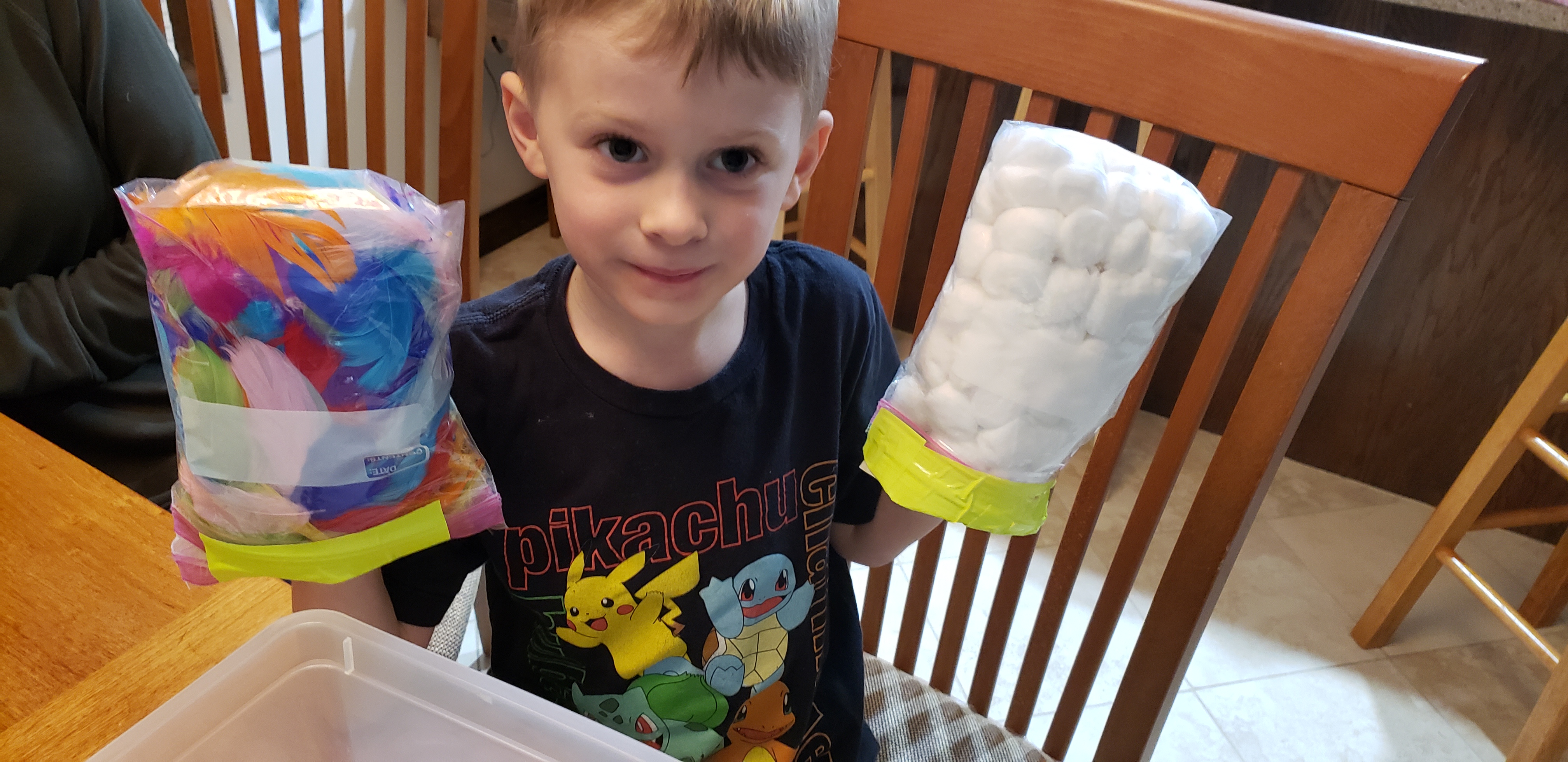 experiment, model, prediction, scientist
experiment, model, prediction, scientistSummary: This lesson or course is designed for K-2 grade (ages 5 - 7). Part 1 uses the students previous knowledge of their surroundings to discuss how animals stay warm in cold weather and compare it to how humans keep warm in cold environments.
Students are asked to consider several animals and the ‘protection’ they have to keep them warm and safe when temperatures get cold.
An experiment follows for students to consider which of the animals’ survival layer or clothing might protect humans the best.
The activity has an option to mathematically consider the data taken from the results.
IL State Science Learning Goal 11: Demonstrate curiosity about the world and begin to use the practices of science and engineering to answer questions and solve problems.
Learning standard 11.a: Develop beginning skills in the use of science and engineering practices, such as observing, asking questions, solving problems, and drawing conclusions.Preschool benchmarks
11.A.ECa Express wonder and curiosity about their world by asking questions, solving problems, and designing things.
11.A.ECb Develop and use models to represent their ideas, observations, and explanations through approaches such as drawing, building, or modeling with clay.
11.A.ECc Plan and carry out simple investigations.
11.A.ECd Collect, describe, compare, and record information from observations and investigations. 11.A.ECe Use mathematical and computational thinking.
11.A.ECf Make meaning from experience and information by describing, talking, and thinking about what happened during an investigation.
11.A.ECg Generate explanations and communicate ideas and/or conclusions about their investigations.
Background: This lesson could be part of the clothing or weather unit in the school curriculum. It is suggested to use in preparation for the “Gloves and Gadget” lesson.
How Do Animals Protect Themselves From the Cold.
Objective: Children wear shorts to stay cool when it’s hot outside, and they wear jackets when it’s cold. How do their pets and other wild animals stay warm when it’s cold? In this lesson, students will learn about how animals keep warm, practice describing their physical observations, and run an experiment dipping hands in cold water to vote on the best way to stay warm! We will extend this information to how astronauts depend on spacesuits to keep them warm. We will extend this information to how astronauts depend on spacesuits to keep them warm.This lesson could be incorporated into the clothing or weather unit.
-
Total Time:
40 minutes
<Insert several pictures of materials - Frances>
Materials:
● 1-2 large bowls or buckets
● Ice cubes and cold water
● Towels
● Whiteboard or chalkboard near demo
● Quart plastic bags (8)
● “Fat” – vegetable shortening (Crisco) (about 2 ½ cups/glove
● Cotton balls (60) or polyester stuffing/glove
● Feathers _120/glove
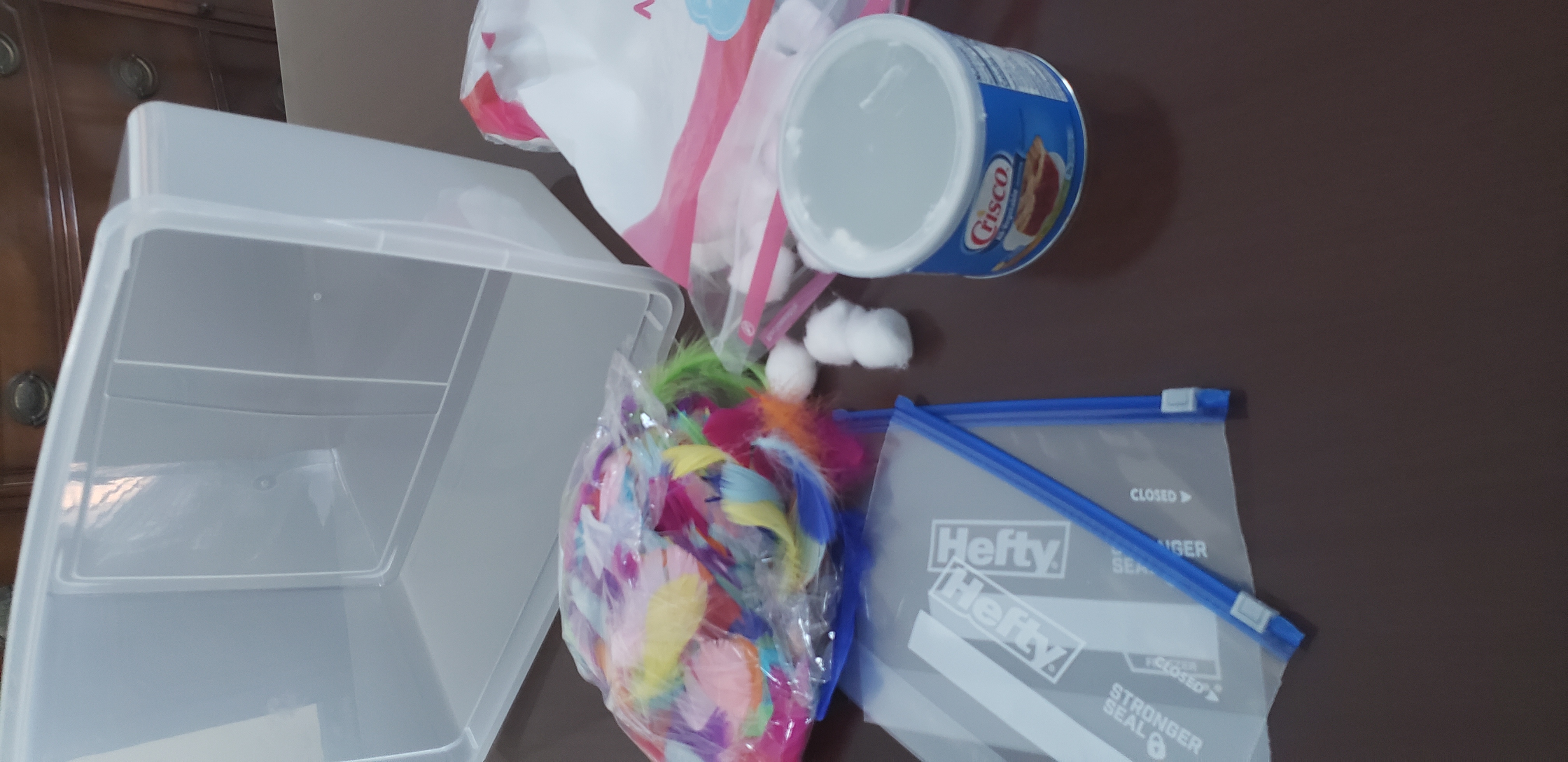
Preparatory Instructions:Make “gloves” out of plastic bags and experiment material (cotton, feathers, and fat):
Fill one bag with one material, place a second bag (inside out) into the first, so that
the second bag is surrounded by material. Seal the bags together with tape or by zipping if possible. Each model will be used like a glove for the student to put on their hand.
1. Prepare the cotton ball model:
Take one of the zip lock bags and fill it with cotton balls (about 60).
Place a second opened ziplock bag inside the middle of the cotton balls.
This will make a glove out of plastic bags and cotton experiment material.
Seal the bags to make a glove. Students will put their hands inside the interior bag.
2. Prepare the feather model:
Take one of the zip lock bags and fill it with feathers (about 120).
Place a second opened ziplock bag inside the middle of the feathers to make a pocket.
Seal the bags to make a glove as noted above.
3. Prepare the fat model:
Take one of the zip lock bags and fill it with lard or solid veg oil (about 3 - 4 cups)
and spread it on the inside of the bag. Make an opening so that you have an pocket
in the bag.
Place a second opened zip lock bag inside the middle of the solid oil.
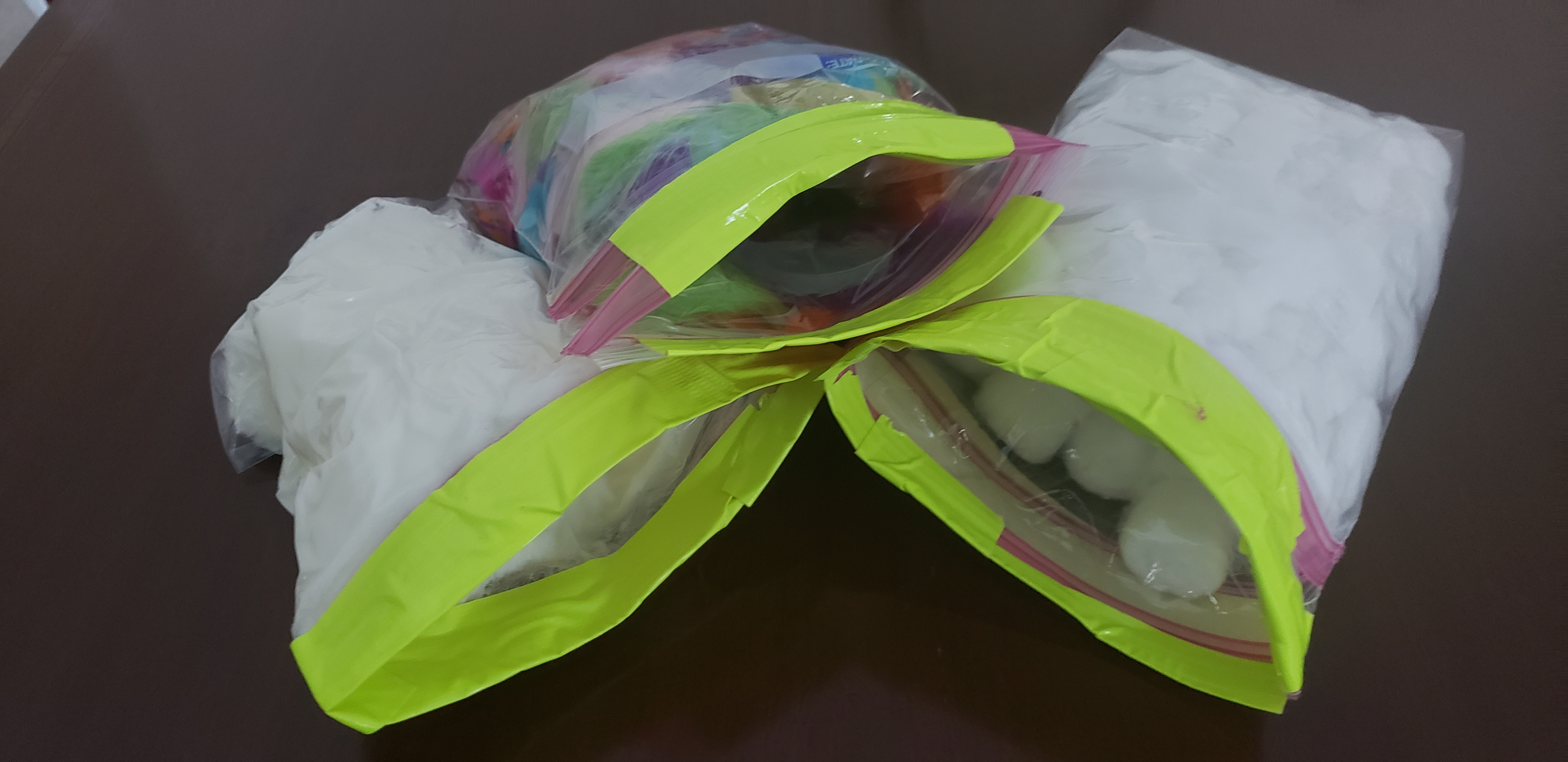
Seal the bags to make a glove as noted above.
Students will put a hand inside the interior bag.
-
What To Do:
5 min Introduce the Lesson (group discussion with class)
Show pictures of humans in the summer and winter - What is the difference between these pictures? (Snow, people wearing jackets/coats/gloves) Why do people wear different clothing in the winter than in the summer?
<Insert a picture of the same outside location 1. In the summer, 2. In theWinter t>
Dramatic Play: What types of clothing do you need to warm in the winter?

Ask a student to be your Helper.
( Bring in a suitcase with winter items in the case- jacket, hat, gloves, scarf, boots)
As the class names the article, ask the Helper to put them on.
Do you have any pets? Show pictures of dogs, cats to solidify concepts.
Why don’t dogs/cats need jackets? (fur)
Pass around a cotton ball and have students describe how it feels. (fuzzy, fluffy, light)
5 min: Direct Instruction (group discussion with class)
Show picture of a bird in snow. How do birds stay warm? (feathers)
Pass around some feathers and have students describe how it feels. (light, ticklish, soft)
Show picture of a seal in snow. How do they seals warm? (layer of fat – “blubber”)
Pass around a bag of fat and have students describe how it feels. (squishy, goopy, gross)
5 min: Motivate the Experiment
Explain: We are using a simple model to “experiment” and explain why animals don’t get cold. We’ll see whether the methods animals use can also keep us warm.
A sensory table could be helpful to have students dip their bare hands in ice water buckets and model descriptive language:
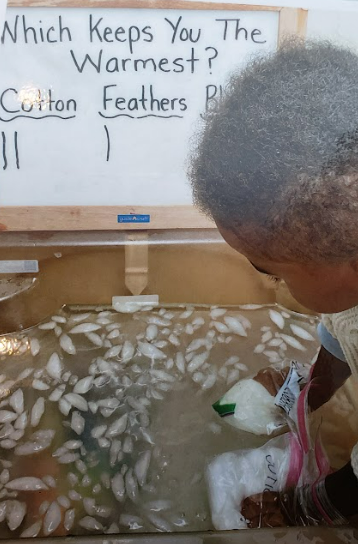
“It’s so cold! My hands are chilly! The ice stings! This is freezing!”
Adventurous students may want to try. You can make it a game by timing them.
[20 min] Conduct the Experiment - Acting Like Scientists
Make predictions:
Model expected language: “I think fat will keep me the warmest!” Why?
Have students predict which material will win by raising hands. Tally the votes.
Model the experiment:
Place each of your hands in a different glove and put them in the water, being careful not to get water inside the bag. Talk about trying to determine which hand feels colder. Say which material kept you warmer.
Conduct the experiment:
Have students approach table one at a time. Put each hand in a different glove then into water. Ask which kept them warmer.
Swap out the losing glove for the remaining third glove. Ask which kept them warmer.
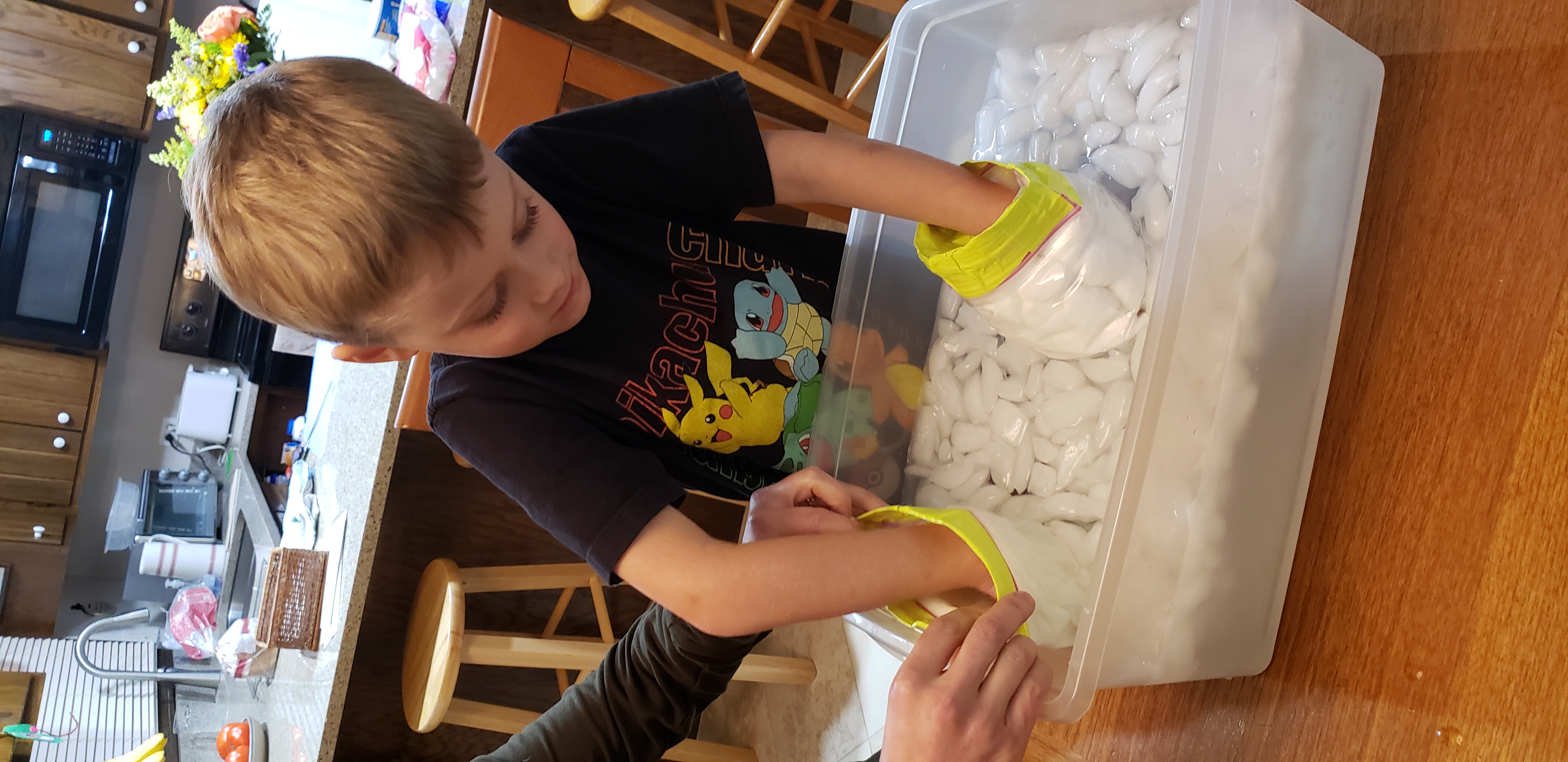
Tally their experimental votes on the board, separate from their predictions.
Analyze results:
Help students identify which material had the most votes, then compare to prediction.
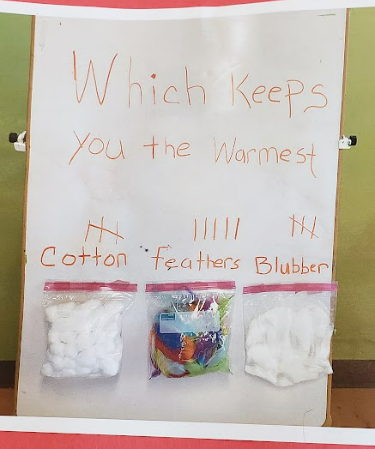
Emphasize that it’s okay to predict incorrectly. That’s the point of experiments!
[3 min] Post-Experiment Discussion
Recap the experiment and how that relates back to animals and your own life. (By running the experiment on different types of materials we were able to determine what type might be best for humans because we used humans to test our materials!)
Next steps: Refer to the Gloves and Gadgets Lesson:
-
Send a Postcard to Space through NSS Supported Blue Origin Club For The Future initiative!
Visit: SpacEdge Academy Postcards in Space Course

-
-
-
-
-
-
-
-
-
-
